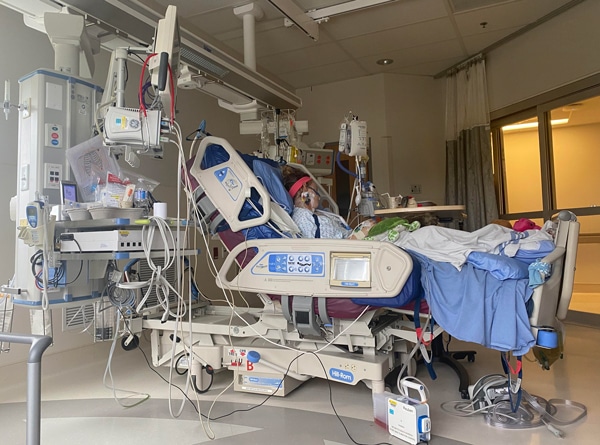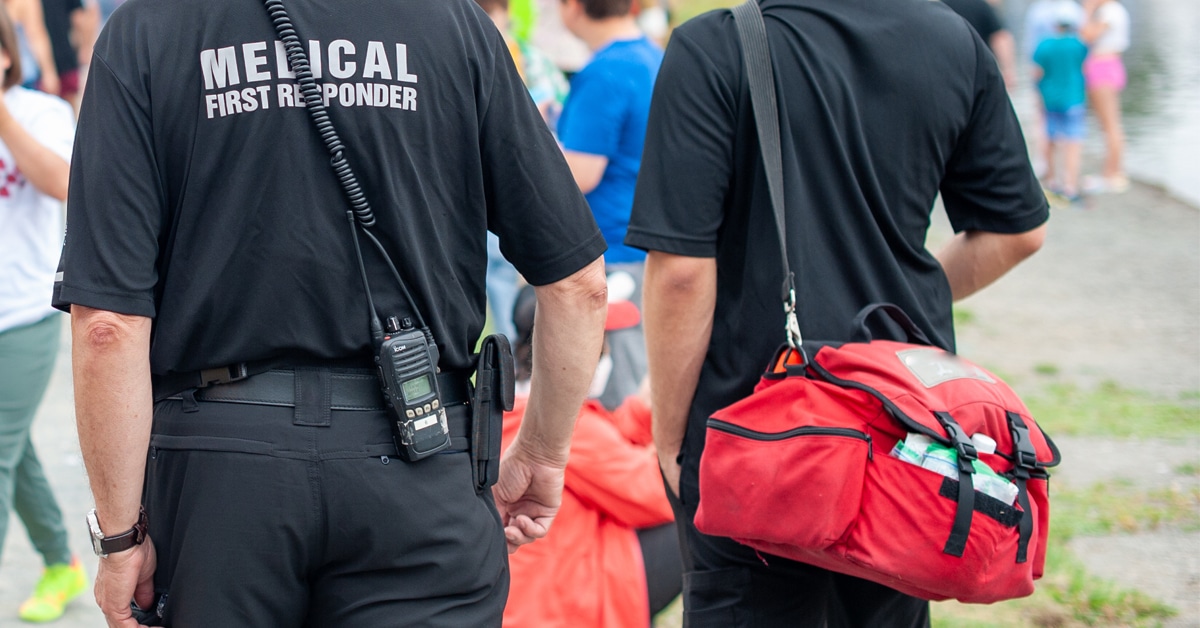Over the years, equine welfare has improved at our North American horse shows as a result of equestrian organizations, horse owners, riders, officials, and other entities working together to address the issues. But what about when it comes to human athlete safety at horse shows? Are we doing enough to protect riders in the show and warm-up rings at Equestrian Canada competitions?
Currently, US Equestrian rules state Qualified Medical Personnel (QMP) with appropriate medical equipment must be present during all scheduled performances at all competitions and during all paid scheduled schooling sessions over fences. US Equestrian defines a QMP as a currently certified or licensed Emergency Medical Technician (EMT), Paramedic, Certified First Responder, physician, or nurse trained and certified in pre-hospital trauma care – Advanced Trauma Life Support (ATLS), Basic Trauma Life Support (BTLS), Pre-hospital Trauma Life Support (PHTLS) – or who has First Responder or comparable certification. US Equestrian strongly recommends that EMTs and/or Paramedics be used to fill the QMP position and for eventing competitions, the minimum requirement is an EMT/Paramedic who is pre-hospital trauma trained.
US Equestrian also requires competitions using more than three performance areas simultaneously to have at least one additional person who is CPR-certified to assist the medical personnel for that competition, two additional people required if more than six performance areas are used simultaneously, and hunter/jumper competitions using four or more rings simultaneously must have at least two QMP present during all performance sessions.
How do these safety measures compare with Equestrian Canada horse shows?
Equestrian Canada (EC) rules state a QMP must be available, but doesn’t make it mandatory that they have to be on the show grounds, stating, “EC strongly recommends qualified medical personnel to be onsite.” Equestrian Canada defines a QMP as a doctor, professional emergency personnel such as EMT or Paramedic, or an adult with recognized and valid First Aid training who is not competing. EC strongly recommended that the minimum certification held by a QMP is First Responder Training, but EC does not make this mandatory. Both US Equestrian and EC state an ambulance must be present or on call.
It’s clear that US Equestrian has a more comprehensive and specialized list of QMPs, and also requires a minimum number of QMPs on horse show grounds depending on the size of the competition. One could argue that the United States is a more litigious country compared to Canada and that they are just trying to cover all their bases. But is professional medical staff with additional training in trauma care something Equestrian Canada should be implementing, and are these specialized QMPs necessary to help protect athletes? We spoke with the experts to find out.
Why Does It Matter?
Holly Russell, a primary care paramedic who also competes in show jumping, weighs in on the importance of horse shows having a QMP that is trained in trauma and managing spinal injuries.

Kali Foster-Harsch was extremely lucky that there was an EMT on site as well as two of her barn mates, a paramedic and nurse, after suffering a life-threatening injury at a horse show. (photo courtesy Kali Foster-Harsch)
“I would personally say it’s extremely important, though there could be a few factors. How close is a higher level of care? This includes the ambulance and the hospital. Some areas can have long wait times, the ambulance service is super taxed for resources due to so many things like lack of urgent care clinics and no access to family general practitioners. Of course, a serious injury would result in a high priority response, but if there are no ambulances, there are no ambulances.
“Show facilities that have paramedics on staff are a huge advantage, in my opinion. We are partners with a 1,200 lb. animal with a mind of their own, and as much as we like to think we can, we can’t predict what’s going to happen. Yes, a lot of our falls end in minor to no injuries, but the possibility of more life-threatening injuries should be taken into account considering our sport.”
When asked how important is it for horse shows to have essential medical equipment on hand, Holly says, “If you have the staff who are trained to use it, and the insurance, then why not? If you have a paramedic holding a license on your staff, give them the tools. Now I say this not knowing what the insurance costs are behind this is but things like intravenous (IV) access in serious injuries can be incredibly important. I can imagine facilities weigh the costs of when equipment expires and insurance to how much this equipment is needed though.”
As Holly points out, some types of medical equipment have expiration dates, which is generally required for all sterile medical devices distributed in Canada and the United States. As a result, show facilities that keep essential medical equipment on hand need to ensure that equipment is checked regularly for inventory levels, expiration dates, and shelf life.
When Every Second Counts
Kali Foster-Harsch knows all too well the importance of having appropriately-trained qualified medical personnel on show grounds. Two years ago, Kali had an unfortunate accident with her horse while schooling over fences at a horse show that resulted in a rotational fall. Lucky for Kali, besides the EMT that was on the show grounds and able to assist Kali right away, two of Kali’s barn mates, a paramedic and nurse, were able to offer assistance.
After trying to intubate Kali and insert a breathing tube, it was discovered that Kali’s bronchial tube had detached from her lung. Due to the additional training of those that came to her aid, Kali survived her fall. She ended up being diagnosed with a severed and detached bronchial tube, 14 broken ribs, a collapsed lung, and a broken shoulder.
When Kali arrived at the hospital, the surgeon stated they didn’t initially believe her injuries were accurate as they’d never seen a live person with them before. The surgeon stated this type of injury is only explained in textbooks because patients normally don’t survive the trip to the emergency room. Kali says, “I owe my life to the trained medics that were on show grounds that day. I wouldn’t be here today if it hadn’t been for them.”
“If a serious fall occurs, all rings should be stopped if there is only one medic on show grounds.”
When asked if EC’s current QMP requirements are enough, Kali says, “Appropriately trained medical staff should be a top priority. Show facilities should be taking more responsibility. Facilities, especially larger ones, need to invest in essential medical equipment so that it is always on-hand. We have show facilities that are 30 minutes or more from a hospital. We are already paying a medic fee. It would be great if an ambulance was on show grounds at these facilities.
“Also, an appropriate number of QMPs need to be on show grounds at larger EC horse shows. It’s a disaster waiting to happen. At a hunter/jumper show last fall, with multiple show rings and warmup rings all running at the same time, three falls occurred in three different rings, yet there was only one QMP on show grounds. They had to decide who to treat first. The problem is, the worst-looking fall isn’t necessarily the most serious. If a serious fall occurs, all rings should be stopped if there is only one medic on show grounds.”
Holly was one of Kali’s barn mates that happened to be in close range of Kali when her accident occurred. In her personal experience, although she feels Kali’s injuries were extremely rare, “Rotational falls are always a possibility with any rider jumping over fences, whether it be show jumping or cross-country. A rotational fall is dangerous and potentially life-threatening no matter what.” Due to the quick response and experience of the QMPs on show grounds that day and a knowledgeable surgeon at the treating hospital, Kali is now back to participating in the equestrian sport she loves.
No Current Industry Standards
Show organizations and competition managers across the country were approached to find out how they are dealing with QMPs and emergency situations at their horses shows.
It appears many show organizations and facilities do not have an ambulance onsite due to the high costs involved.
Many organizations are doing their part to ensure the QMP is not needed in multiple rings at one time. Andrew Curry, immediate past president of the Manitoba Hunter Jumper Association, says, “If a rider is injured and requires medical attention that will take more time, or the rider needs to be transported by ambulance, then the rings will shut down until the medic is available again. If two medics are present, then the second ring can continue.”
It appears many show organizations and facilities do not have an ambulance onsite due to the high costs involved. That being said, nearly all eventing and vaulting competitions across Canada have an ambulance onsite for the duration of competitions.
Christine Reupke, EC Senior and FEI jumper judge, runs an EC silver hunter/jumper series in Ontario called The Classic Series. She has also been the director of Equestrian & Breed Sport for the Royal Winter Fair in Toronto for over 10 years. Christine says, “As a competition manager, safety, efficiency and good management is imperative when selecting medical personnel. For my silver show, I hire an ACP (Advanced Care Paramedic). I have used the same person for a few years and the consistency brings a level of comfort for both parties. She has many years’ experience with equestrian injuries and ensures her skills are kept up-to-date. My paramedic is $45.00 per hour. I absorb the cost for my silver show, but at the Royal we do show it as a charge on the client invoice of $25.” Christine’s paramedic charges similar fees to other paramedics across the country. The majority of horse show organizers say they are paying anywhere between $45 to $55 an hour for a paramedic to be on show grounds.
Minimize the Risks
What you can do to help minimize your risks as an equestrian athlete:
- Always wear an approved, properly fitted and secured helmet every time you ride.
- Consider purchasing an air vest. It is important to note that air and safety vets are allowed in any competition ring in
- North America without penalty, regardless of the discipline.
- Make sure all riding equipment is in good condition and secured properly.
- Consider using safety stirrups that break away if you should fall off your horse.
- Ensure that both the horse and riding activity are appropriate for the rider’s skill level.
- Work with an experienced and knowledgeable riding instructor or competition coach.
- Be aware of concussion signs and symptoms.
- Support horse shows that have both horse and rider safety and welfare at the top of their list.
Will using more specialized Qualified Medical Personnel increase the paramedic fees at competitions that don’t currently utilize these professionals? Most likely. Could it help save the life of a human athlete when the unthinkable happens and every second counts? Most definitely.
***
Tracy Dopko is an FEI L1 Jumper, Para-Dressage and Vaulting Steward, USEF judge, EC Senior Judge and Senior Steward.

